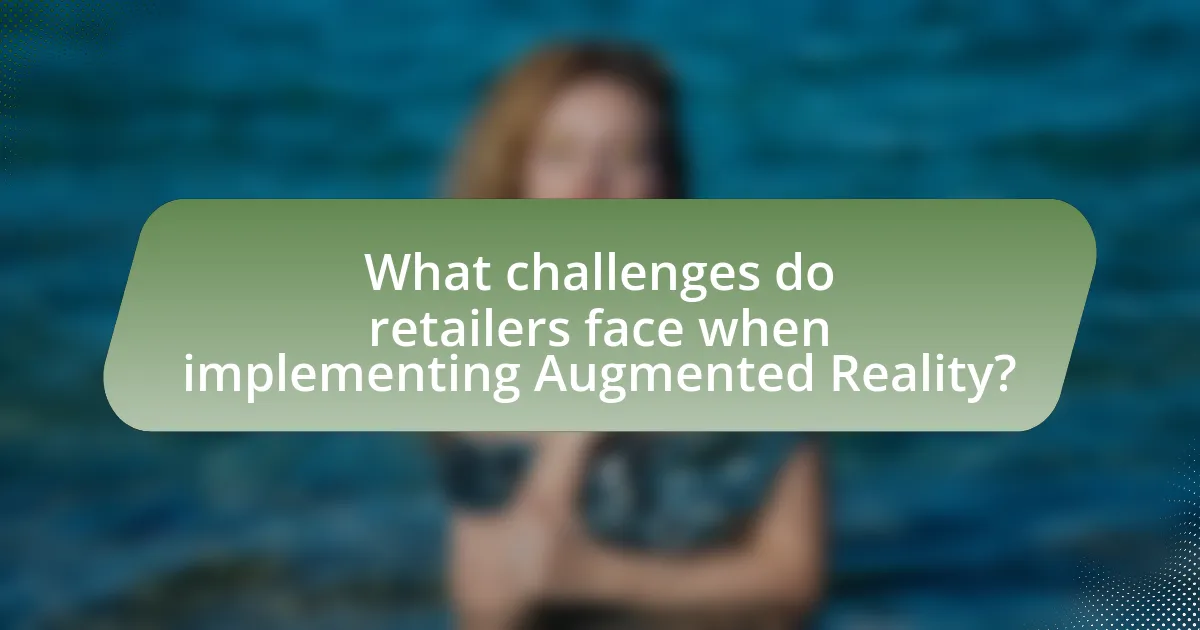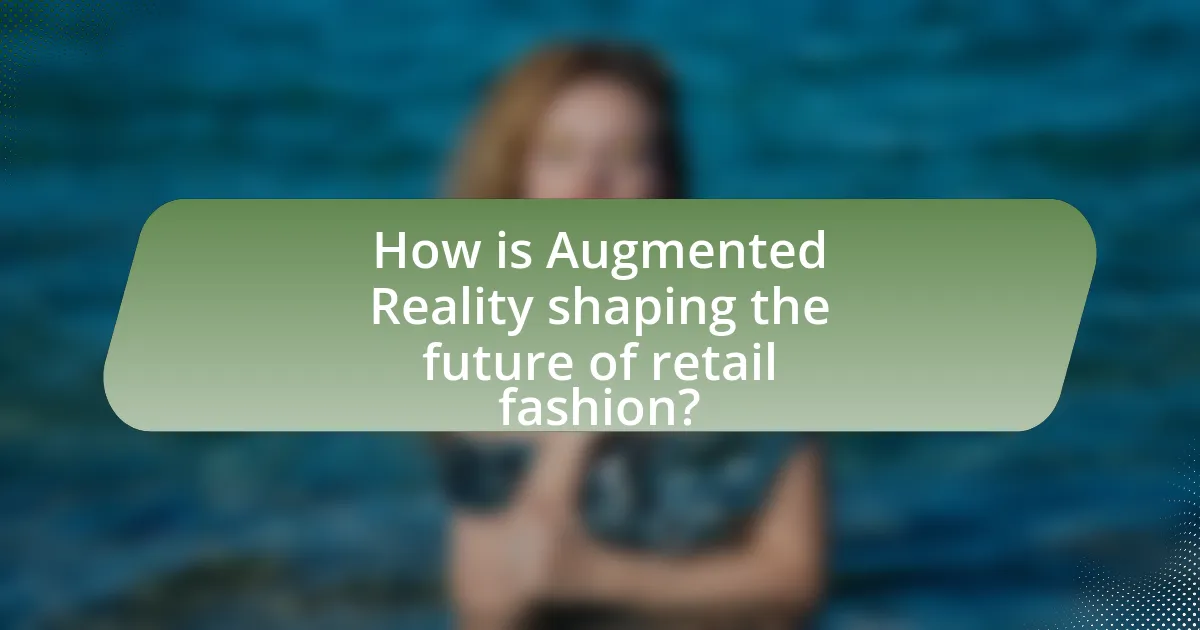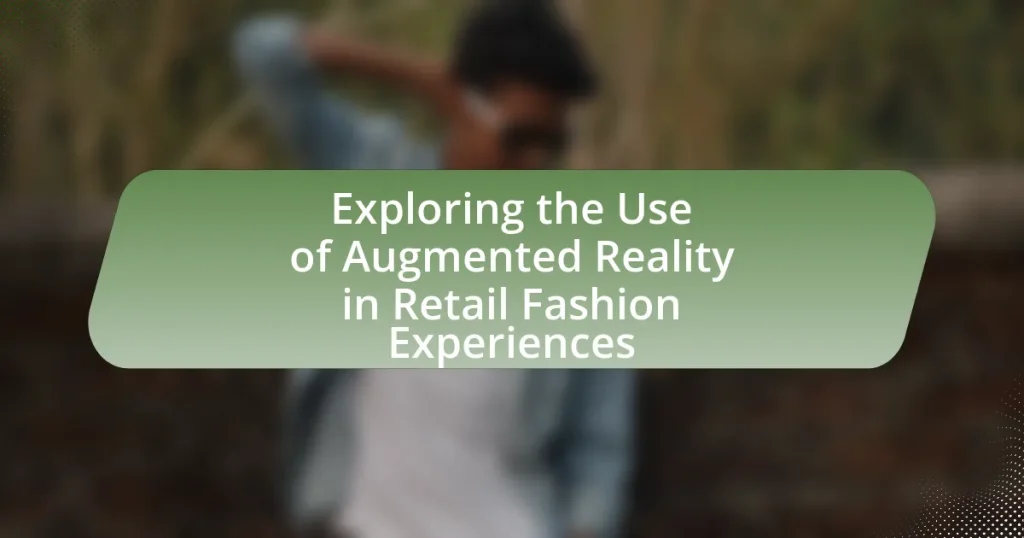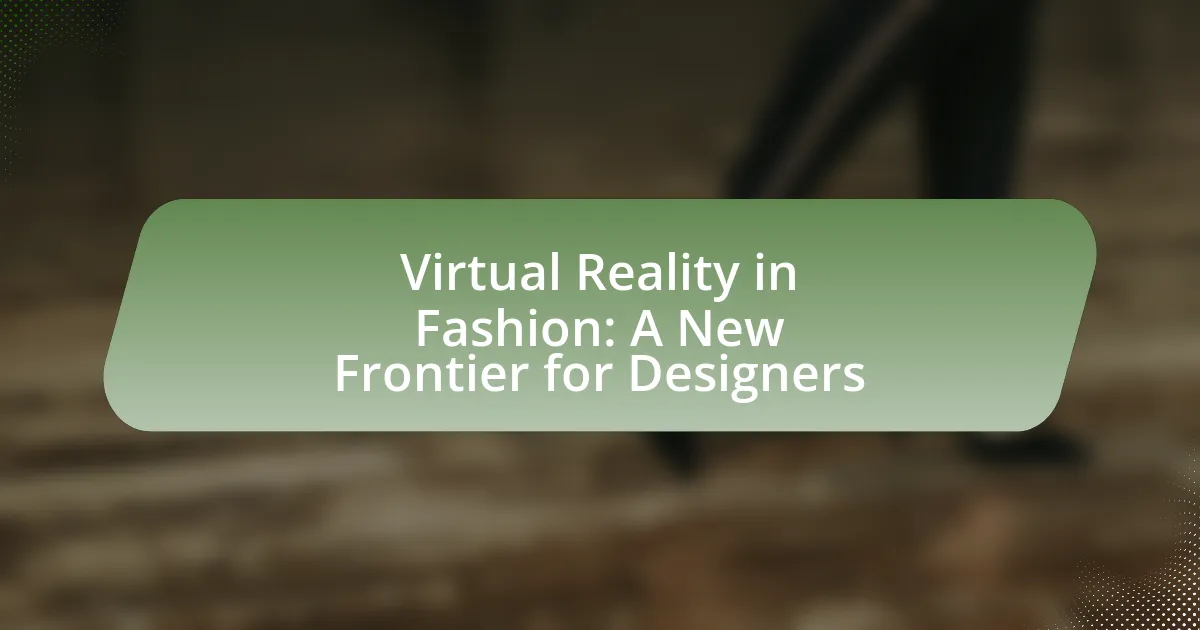Augmented Reality (AR) is revolutionizing retail fashion experiences by integrating digital elements into physical shopping environments, allowing customers to visualize products interactively. This technology enhances the shopping experience through virtual try-ons, significantly increasing customer engagement and reducing return rates. Key benefits include improved purchase confidence, with studies indicating that AR can boost sales conversion rates by up to 40%. However, retailers face challenges such as high development costs and privacy concerns, necessitating robust security measures and user-friendly applications. The article explores the technologies involved, consumer interactions, emerging trends, and best practices for effectively implementing AR in retail fashion.

What is Augmented Reality in Retail Fashion Experiences?
Augmented Reality (AR) in retail fashion experiences refers to the integration of digital elements into the physical shopping environment, allowing customers to visualize products in an interactive manner. This technology enhances the shopping experience by enabling virtual try-ons, where consumers can see how clothing or accessories would look on them without physically wearing them. For instance, brands like Gucci and Zara have implemented AR features in their apps, allowing users to project clothing items onto their own bodies through their smartphones. This approach not only increases customer engagement but also reduces return rates, as studies indicate that AR can improve purchase confidence by up to 40%.
How does Augmented Reality enhance the shopping experience?
Augmented Reality (AR) enhances the shopping experience by allowing customers to visualize products in their real-world environment before making a purchase. This technology enables users to try on clothing virtually, see how furniture fits in their homes, or visualize makeup on their faces, thereby increasing confidence in their buying decisions. According to a study by Deloitte, 40% of consumers are willing to pay more for a product if they can experience it through AR, demonstrating its effectiveness in driving sales and customer satisfaction.
What technologies are involved in Augmented Reality applications?
Augmented Reality applications involve several key technologies, including computer vision, simultaneous localization and mapping (SLAM), depth tracking, and display technologies such as smartphones, tablets, and smart glasses. Computer vision enables the recognition of real-world objects and environments, while SLAM allows devices to map surroundings and track their position in real-time. Depth tracking enhances the interaction between virtual and real elements by measuring distances accurately. Display technologies are crucial for rendering augmented content, making it visible to users in an immersive manner. These technologies collectively facilitate the integration of digital information with the physical world, enhancing user experiences in various applications, including retail fashion.
How do consumers interact with Augmented Reality in retail fashion?
Consumers interact with Augmented Reality (AR) in retail fashion primarily through virtual try-ons and immersive shopping experiences. This interaction allows consumers to visualize clothing and accessories on themselves without physically trying them on, enhancing their shopping experience. For instance, a study by Accenture found that 40% of consumers are willing to pay more for a product if they can experience it through AR. Additionally, brands like Gucci and Zara have implemented AR features in their apps, enabling users to see how items look in real-time, which increases engagement and purchase intent.
What are the key benefits of using Augmented Reality in retail fashion?
The key benefits of using Augmented Reality (AR) in retail fashion include enhanced customer engagement, improved shopping experience, and increased sales conversion rates. AR allows customers to virtually try on clothing and accessories, which significantly boosts engagement by providing an interactive experience. According to a study by Deloitte, retailers that implemented AR saw a 40% increase in customer engagement and a 30% increase in conversion rates. Additionally, AR reduces return rates by allowing customers to visualize how products will look on them before making a purchase, leading to more informed buying decisions.
How does Augmented Reality improve customer engagement?
Augmented Reality (AR) improves customer engagement by providing interactive and immersive experiences that enhance product visualization. This technology allows customers to visualize how products will look in real life, leading to increased satisfaction and reduced return rates. For instance, a study by Deloitte found that 40% of consumers are more likely to make a purchase after using AR to visualize products. Additionally, AR can create a memorable shopping experience, fostering emotional connections with brands, which is crucial in the competitive retail fashion market.
What impact does Augmented Reality have on sales and conversion rates?
Augmented Reality (AR) significantly enhances sales and conversion rates in retail fashion by providing immersive shopping experiences that engage customers. Research indicates that AR can increase conversion rates by up to 40%, as it allows consumers to visualize products in their own environment, leading to more informed purchasing decisions. For instance, a study by Deloitte found that retailers using AR saw a 30% increase in customer engagement and a 20% boost in sales. This demonstrates that AR not only attracts customers but also facilitates a deeper connection with products, ultimately driving higher sales and improved conversion rates.

What challenges do retailers face when implementing Augmented Reality?
Retailers face several challenges when implementing Augmented Reality (AR), including high development costs, technical limitations, and user adoption issues. High development costs arise from the need for specialized software and hardware, which can strain budgets, especially for smaller retailers. Technical limitations include the need for robust infrastructure and compatibility with various devices, which can complicate deployment. User adoption issues stem from a lack of familiarity with AR technology among consumers, leading to potential resistance or underutilization of AR features. These challenges can hinder the effective integration of AR into retail strategies, impacting overall customer experience and engagement.
How can retailers overcome technical barriers to Augmented Reality adoption?
Retailers can overcome technical barriers to Augmented Reality (AR) adoption by investing in robust infrastructure and user-friendly software solutions. By upgrading their hardware capabilities, such as high-speed internet and compatible devices, retailers can ensure a seamless AR experience. Additionally, partnering with experienced AR developers can facilitate the creation of intuitive applications that enhance user engagement. Research indicates that 61% of consumers prefer retailers that offer AR experiences, highlighting the importance of overcoming these barriers to meet customer expectations and drive sales.
What are the costs associated with developing Augmented Reality solutions?
The costs associated with developing Augmented Reality (AR) solutions typically range from $50,000 to over $500,000, depending on the complexity and features required. Development costs are influenced by factors such as the type of AR technology used (marker-based, markerless, or projection-based), the platform (iOS, Android, or web), and the level of interactivity desired. For instance, a simple AR application may cost around $50,000, while a highly interactive and immersive experience could exceed $500,000. Additionally, ongoing maintenance, updates, and potential hardware requirements can further increase the overall investment.
How do retailers ensure a seamless user experience with Augmented Reality?
Retailers ensure a seamless user experience with Augmented Reality (AR) by integrating intuitive interfaces and high-quality visuals that enhance customer engagement. They utilize user-friendly applications that allow customers to easily navigate AR features, such as virtual try-ons or product visualizations. For instance, brands like IKEA and Sephora have developed AR tools that enable users to visualize furniture in their homes or try on makeup virtually, respectively. These applications are designed to minimize loading times and technical glitches, ensuring smooth interactions. Additionally, retailers often conduct user testing and gather feedback to refine their AR experiences, which helps in addressing any usability issues and improving overall satisfaction.
What are the privacy and security concerns related to Augmented Reality in retail?
Privacy and security concerns related to Augmented Reality (AR) in retail include data collection, user tracking, and potential breaches of personal information. Retailers utilizing AR often collect sensitive data such as location, shopping habits, and biometric information, which can lead to unauthorized access or misuse if not properly secured. For instance, a study by the International Data Corporation (IDC) highlights that 60% of consumers are worried about how their data is used in AR applications. Additionally, AR systems can be vulnerable to cyberattacks, which may compromise customer data and trust. These concerns necessitate robust security measures and transparent data policies to protect consumer privacy in the retail environment.
How do retailers protect customer data while using Augmented Reality?
Retailers protect customer data while using Augmented Reality by implementing robust data encryption, secure data storage solutions, and strict access controls. Data encryption ensures that any customer information transmitted during AR interactions is encoded, making it unreadable to unauthorized users. Secure data storage solutions, such as cloud services with advanced security protocols, safeguard sensitive information from breaches. Additionally, strict access controls limit who can view or manipulate customer data, ensuring that only authorized personnel have access. According to a report by the International Data Corporation, 70% of organizations that adopt AR technologies prioritize data security measures to protect customer information, highlighting the industry’s commitment to safeguarding privacy.
What regulations must retailers consider when implementing Augmented Reality?
Retailers must consider data protection regulations, consumer protection laws, and intellectual property rights when implementing Augmented Reality (AR). Data protection regulations, such as the General Data Protection Regulation (GDPR) in Europe, require retailers to ensure that any personal data collected through AR applications is handled securely and with user consent. Consumer protection laws mandate that AR experiences must not mislead consumers regarding products, ensuring transparency and accuracy in representations. Additionally, retailers must respect intellectual property rights by ensuring that any AR content does not infringe on copyrights or trademarks, which can lead to legal disputes. These regulations are crucial for maintaining compliance and fostering consumer trust in AR technologies.

How is Augmented Reality shaping the future of retail fashion?
Augmented Reality (AR) is transforming the future of retail fashion by enhancing customer engagement and improving the shopping experience. Retailers are increasingly adopting AR technologies to allow customers to virtually try on clothing and accessories, which reduces the need for physical fitting rooms and minimizes return rates. For instance, a study by Deloitte found that AR can increase conversion rates by up to 40% when customers can visualize products on themselves before purchasing. Additionally, brands like Gucci and Zara have implemented AR features in their mobile apps, enabling users to see how items look in real-time, thereby driving sales and customer satisfaction. This integration of AR not only personalizes the shopping experience but also aligns with the growing demand for innovative and interactive retail solutions.
What trends are emerging in Augmented Reality for retail fashion?
Emerging trends in Augmented Reality (AR) for retail fashion include virtual try-ons, enhanced customer engagement through interactive experiences, and the integration of AR with social media platforms. Virtual try-ons allow customers to visualize how clothing and accessories will look on them without physical fitting, significantly improving the online shopping experience. According to a report by Gartner, 100 million consumers will shop using AR online and in-store by 2025, highlighting the growing acceptance and demand for this technology. Additionally, brands are leveraging AR to create immersive storytelling experiences, allowing customers to interact with products in a more engaging manner, which has been shown to increase conversion rates.
How are brands innovating with Augmented Reality experiences?
Brands are innovating with Augmented Reality (AR) experiences by integrating virtual try-on solutions, enhancing customer engagement, and personalizing shopping experiences. For instance, companies like Gucci and Nike have developed AR applications that allow customers to visualize how products, such as shoes or accessories, will look on them before making a purchase. This innovation not only reduces return rates but also increases customer satisfaction, as evidenced by a report from Deloitte indicating that 40% of consumers are more likely to purchase a product after using AR technology. Additionally, brands are utilizing AR for interactive marketing campaigns, such as virtual fashion shows or immersive storytelling, which further captivates consumers and drives brand loyalty.
What role does social media play in the adoption of Augmented Reality in retail?
Social media significantly accelerates the adoption of Augmented Reality (AR) in retail by providing a platform for brands to showcase AR experiences and engage consumers. Retailers leverage social media channels like Instagram and Snapchat to integrate AR features, allowing users to virtually try on products, which enhances customer interaction and drives sales. For instance, a study by Deloitte found that 40% of consumers are more likely to purchase a product after experiencing AR on social media. This engagement not only increases brand visibility but also fosters a community around AR experiences, encouraging more retailers to adopt this technology to remain competitive.
What best practices should retailers follow when integrating Augmented Reality?
Retailers should prioritize user experience, ensuring that Augmented Reality (AR) applications are intuitive and engaging. This involves designing AR features that are easy to navigate and provide clear value, such as virtual try-ons or interactive product displays. Research indicates that 71% of consumers prefer shopping at retailers that offer AR experiences, highlighting the importance of user-centric design. Additionally, retailers should ensure compatibility across devices to maximize accessibility, as 85% of consumers use smartphones for shopping. Integrating AR with existing marketing strategies can enhance brand storytelling, making the shopping experience more immersive and memorable.
How can retailers effectively market their Augmented Reality features?
Retailers can effectively market their Augmented Reality (AR) features by integrating them into their overall marketing strategy and promoting user engagement. For instance, retailers can utilize social media platforms to showcase AR experiences through interactive posts and advertisements, which can increase consumer interest and drive traffic to their apps or websites. According to a study by Deloitte, 88% of consumers reported that AR experiences enhance their shopping experience, indicating that effective marketing of AR can lead to higher customer satisfaction and increased sales. Additionally, retailers can offer incentives, such as exclusive discounts or rewards for using AR features, further encouraging customer participation and loyalty.
What metrics should retailers track to measure the success of Augmented Reality initiatives?
Retailers should track metrics such as user engagement, conversion rates, and customer satisfaction to measure the success of Augmented Reality initiatives. User engagement can be assessed through the duration of AR interactions and the frequency of use, indicating how effectively the AR experience captures consumer interest. Conversion rates reflect the percentage of users who make a purchase after interacting with AR features, providing insight into the effectiveness of AR in driving sales. Customer satisfaction can be measured through surveys and feedback, revealing how well the AR experience meets consumer expectations and enhances their shopping journey. These metrics collectively provide a comprehensive view of the impact of Augmented Reality on retail performance.




